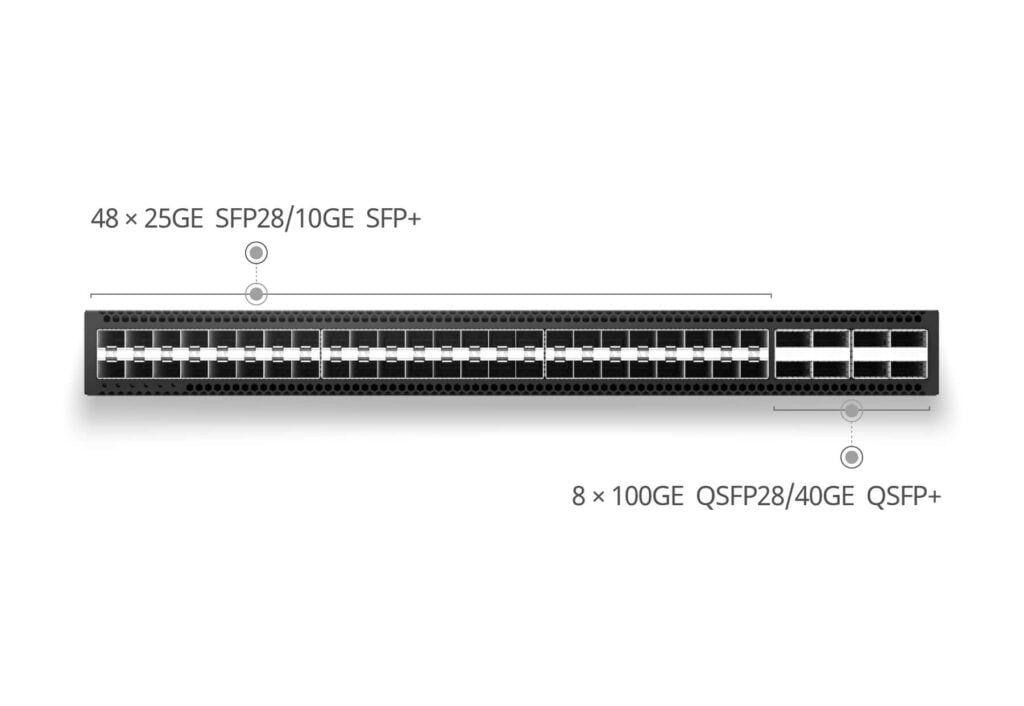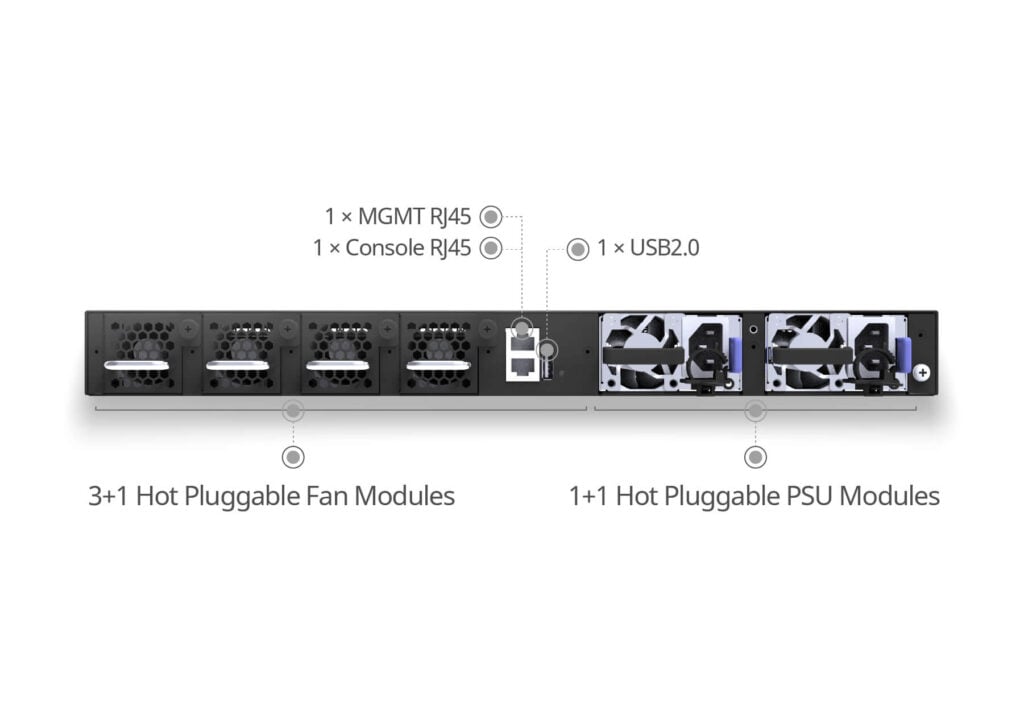48×25G Data Center Switch: Performance, SONiC, and Deployment Q&As
written by Asterfuison
Table of Contents
Introduction
Asterfusion’s CX308P-48Y-N-V2 data center switch, featuring 48-port 25Gb SFP28 and 8-port 100Gb QSFP28 uplinks, is a compact yet powerful choice for building spine-leaf topologies, scalable top-of-rack networks, and multi-tenant cloud fabrics.
Backed by the Marvell Falcon chip and preloaded with Asterfusion Enterprise SONiC, this 25G data center switch delivers line-rate Layer 3 routing, rich telemetry, a massive IPv4 routing table capacity that easily manages complex BGP routing and supports multi-tenant virtual networks.
In this blog, we answer 30+ real-world customer questions—organized by performance, deployment, software, security, and more.


Hardware Capabilities
Q: Does it support hot-swappable fan/power modules, fan/power redundancy, and related alarms?
A: Both modules support redundancy. Fans are 3+1 redundant, and power supplies are 1+1 redundant. Both support hot-swapping and module alarms. By enabling the AsterNOS exporter (Prometheus exporter), the operating status of modules can be monitored.
Q: Is a 25G data center switch compatible with future 100G spine / 400G core upgrades?
A: Yes. The device itself, as a box device, does not involve hardware upgrades. When upgrading Spine or core devices, the 100G uplink ports can continue to be used for seamless compatibility.
Q: How many IPv4 and IPv6 routing entries does it support max.? Is it fully hardware-forwarding?
A: Supports IPv4: 288K / IPv6: 144K entries in hardware with full wire-speed Layer 3 routing and no compromise on features.
Q: Does it support dual-stack IPv4/IPv6 in high-density routing scenarios? Is there any performance degradation under dual-stack?
A: It supports dual-stack high-density routing scenarios (e.g., IPv4: 144K / IPv6: 72K). Thanks to the dedicated routing engine, there is no performance degradation under dual-stack.
Q: Is 2600Mpps wire-speed forwarding? What packet sizes are supported?
A: 2600Mpps is the packet forwarding value tested based on small packets of 64B. Under 64B small packets, it is not wire-speed forwarding. The minimum byte size for wire-speed forwarding is 170B, at which point the packet forwarding rate is 2631Mpps.
Q: Does it support VXLAN routing (Layer3 VNI), ECMP, and BGP-EVPN?
A: It supports VXLAN Routing and Bridging, Layer 2 VNI, and Layer 3 VNI. It also supports BGP-EVPN, 4K group, and 256-member ECMP.
Q: What port types and breakout modes are supported? Does it support 4x10G breakout?
A: This switch supports 48x25G SFP28 ports and 8x100G QSFP28 ports. The 25G ports are backward compatible with 10G, and the 100G ports are backward compatible with 40G. Additionally, the 100G/40G ports support a 1×4 breakout.
Q: Does it support non-disruptive software upgrades (ISSU) or cold reboot without losing configuration?
A: Unlike traditional vendors’ ISSU, which relies on HA/multi-main controller redundancy mechanisms, thanks to SONiC’s container-level isolation and microservice architecture, it supports a hot patch mechanism. In the event of a failure in a specific module, the service container can be restarted without rebooting the entire system.
Q: Data centers have high security isolation requirements. Does it support MACsec or port security features?
A: It supports configuring MACsec and port-isolate to meet users’ security isolation needs.
Enterprise SONiC Features
Q: What’s different in Asterfusion Enterprise SONiC vs community SONiC?
A: Our Enterprise SONiC Distribution is based on open-source SONiC and has been deeply optimized for AIDC and Enterprise scenarios. Compared to the community version, it offers significant advantages in management interfaces (e.g., REST API, NetConf/YANG, gNMI), control plane features (e.g., Packet Spray, WCMP, INT Driven Routing, Anycast Gateway WiFi Roaming, EVPN-MH), hardware compatibility (e.g., Marvell TL, Prestera; BCM Tomahawk III, Trident III), and production stability. For details, refer to the comparison list on our website.
Q: Does it support the FRR routing stack? Does it support the full protocol stack for BGP/OSPF/ISIS?
A: AsterNOS is based on the FRRouting (FRR) stack, providing powerful and reliable control plane functionality. FRR currently supports the following protocols: BGP, OSPFv2, OSPFv3, RIPv1, RIPv2, RIPng, IS-IS, PIM-SM/MSDP, LDP, BFD, Babel, PBR, and OpenFabric. It fully supports BGP, OSPF, and ISIS protocol stacks.
Q: Does it support automatic route injection and deduplication under the VXLAN+EVPN architecture?
A: Yes, VXLAN-EVPN currently uses Type-2 routes to implement host MAC address announcements, host ARP announcements, and host IP route announcements to achieve automatic route injection and deduplication.
Q: Does it support automatic management (ZTP, gNMI, OpenConfig, REST API)? Has it been integrated with Ansible/Puppet?
A: Supports ZTP, gNMI, and REST API. Integration-ready with Ansible/Puppet. Ansible plugins provided.
Q: Does it support data center features such as ACL, QoS, SPAN, ERSPAN, Telemetry, and sFlow?
A: Yes, all of these are supported as they are standard data center features.
Q: Does it support neighbor discovery protocols such as LLDP, CDP, and NDP? This is convenient for debugging and asset management.
A: LLDP and NDP are supported. CDP is not supported as it is a Cisco proprietary protocol.
Q: Does it support system-level Telemetry reporting? Can it integrate with Prometheus or Grafana?
A: Through the INT collector, it can collect and report network status information in real-time on the data plane. With the INT function, the switch can provide training traffic with microburst detection, latency monitoring, and queue congestion reporting. It supports enabling the AsterNOS exporter (Prometheus exporter) to monitor network operating status and integrates with the Prometheus monitoring platform for visualization.
Security & Multi-Tenancy Capabilities
Q: Does it support MACsec or port-level encryption? Does it support VLAN/VRF-based multi-tenant isolation?
A: It supports MACsec. By configuring VXLAN-EVPN, VLAN/VRF-based multi-tenant isolation is supported, along with 4K VLANs and 1K VRFs.
Q: Does it support RADIUS/TACACS+/AAA authentication systems?
A: Currently, RADIUS/TACACS+/AAA authentication systems are supported.
Q: Does it have an RBAC (Role-Based Access Control) mechanism? Does it support multi-administrator delegated operations?
A: It supports configuring user permission levels. Currently, four levels are supported: none, show, config, and sys_admin.
Q: Does it support SSH Key for secure access?
A: Yes, it supports SSH Key secure access.
Q: Does it support configuration rollback?
A: Currently, direct configuration rollback is not supported. However, it can be achieved manually by overwriting the config_db.json file and reloading it.
Deployment & Compatibility
Q: Can the 25G Data Center Switch be used in Spine-Leaf architectures? Is it applicable to both Top-of-Rack and Leaf layers?
A: This switch is positioned as a data center switch, specifically designed for the Spine-Leaf architecture. As a Spine, it can scale to a maximum of 80x25G ports ( 100G ports can be split into 4x25G, so 4×8+48=80). It is suitable for both Top-of-Rack (supports AOC, DAC, ACC, AEC) and Leaf (supports various optical modules).
Q7: Is it compatible with Arista, Cisco, and Nokia devices?
A: Yes, we are a standard Ethernet device and support universal standard protocols, ensuring full compatibility with devices from mainstream vendors.
Q: Is it compatible with common 25G optical modules such as SR, LR, BiDi, CWDM4? Does it support DDM?
A: It is compatible with common 25G optical modules on the market, including SR, LR, BiDi, and CWDM4. We also support DDM/DOM functionality.
Q: Does it support MC-LAG and EVPN multi-homing?
Yes. Provides active-active redundancy and load balancing via MC-LAG and EVPN-MH. It supports complete MC-LAG features and also supports EVPN-Multihoming functionality, providing an all-active redundancy mechanism to achieve load balancing and fault convergence.
Q: Does this 25G data center switch support OOB management?
A: Yes. It supports OOB management. Comes with 1GE RJ45 management port, accessible via SSH.
TCO & Commercial Considerations
Q: Compared with similar vendors (e.g., white-box + SONiC combination), what are Asterfusion’s advantages in TCO?
A: Unlike other white-box + SONiC combinations, we offer an open network switch solution (commercially enhanced SONiC + hardware box). Therefore, the TCO advantage mainly lies in the open network switch. Based on software-hardware decoupling, we ensure high reliability while supporting advanced chip features.
Q: Does it support batch factory pre-configuration? Do you offer managed deployment or remote support services?
A: The 25G data center switch supports ZTP (Zero-Touch Provisioning) deployment, and we do provide remote support services.
Q: What’s the standard lead time? Are demo units available?
A: Delivery in 1–2 weeks. Demo units are available at discounted rates.
Q: Does Asterfusion have large-scale data center deployment cases? Can you provide examples of topology and architecture?
A: Yes. We have large customer deployments in production. Contact us or check the blog for references.
Conclusion
The Asterfusion CX308P-48Y-N-V2 data center switch combines 25G high-density access with 100G uplinks, VXLAN routing, SONiC automation, and secure multi-tenant networking—all in one reliable, cost-effective platform. Whether you’re deploying in cloud-scale environments, enterprise data centers, or building a scalable AI-ready fabric, this 25G data center switch brings open networking with enterprise-grade reliability and visibility.
Still have questions or want a trial unit? Contact our team to schedule a demo or deployment consultation.



